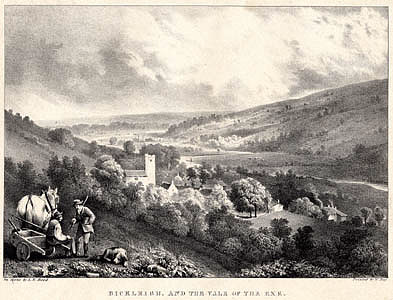
Welcome to Bickleigh
On a hill about 10 miles north of Exeter, Bickleigh is thought to date from the first years of the Saxon occupation. The name-form Bickleigh developed from the Saxon "Bicanleag". This is a compound of two Old English elements, bica and lēah. The second element lēah usually means ‘woodland clearing’ but in some contexts can also mean ‘wood’ or ‘pasture’ (*1) The first element bica seems originally to have meant ‘beak’ and then developed the sense of ‘point’ (*2) The most probable interpretation of the name-form Bicanleag is therefore ‘pointed clearing’. This is likely to refer to present day Bickleigh Village, a large proportion of which still lies between the confluence of the Exe and the Dart, forming a pointed area of raised land.
Bickleigh Village is located at a convergence of important ancient routeways.The village also enjoys a plentiful supply of natural springs, many wells, good soil, sunny aspect and incredible views across the valley. It is not difficult to see why early settlers selected this location.
Prior to the Norman Conquest, it is believed that Bickleigh was part of the Silverton Royal Estate and the likely location of a Royal Hunting Lodge(*3). It is entirely possible that in AD904, King Edward the Elder, the Archbishop of Canterbury and other important dignitaries, aswell as their immediate retinues and others, (potentially amounting to some four hundred people! *4) witnessed the signing of four Anglo Saxon Charters in Bickleigh. (*3)
There are many picturesque cottages with cob walls and thatched roofs, some dating back to the late medieval period. Although no trace remains, it is probable that a Church was first built on the site of St Mary's during the Saxon occupation of the valley in 700 AD. Indeed the Church may have origins as a early territories folk shrine due to its hillside location near several under and overground streams.
We believe it is important to be reminded of the people, events and natural resources that have made our communities what they are today. We enjoy celebrating the past and know that our everyday lives are enhanced when we understand more about where we live. The photographs on this website are a vital record of the history and inhabitants of the ancient settlement of Bickleigh or "Bicanleag", which have been brought together from across the community and presented here for all to treasure.
*1. Smith 1956: 2 18-20; Gelling & Cole 2000: 237-9.
*2. Smith 1956: 1 33-4; Parsons et al. 1997: 96.
*3 Charter Numbers S372, S373, S374, S1286. See www.esawyer.co.uk and references to Bicanleag "illa uenatoria uilla que saxonica dicitur Bicanleag..." "A Hunting vill that the Saxons call Bicanleag"
*4 With reference to the council meeting held at Grately, Hampshire in c.925 x 930

